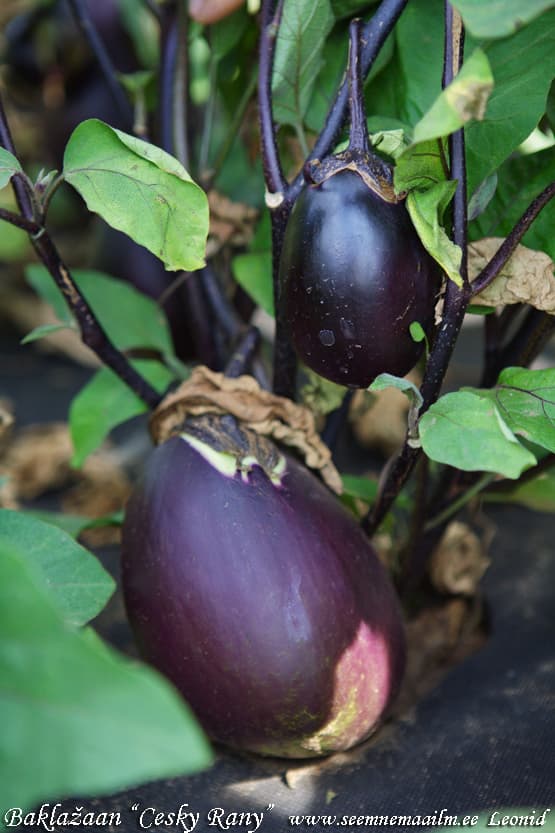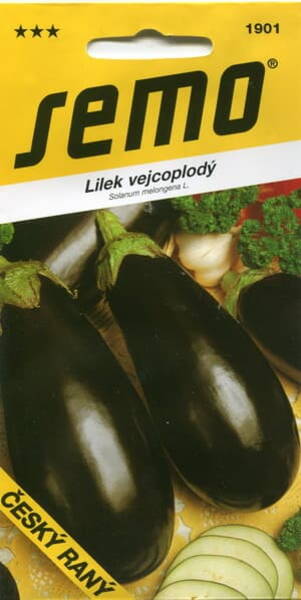An early variety, fit also for less warm conditions. The fruits are egg-shaped, smooth and dark purple. The plant is strong and compact.
1,0 g = 260 seeds.

Agricultural technology.
Eggplant seeds are sown in late February - early March. The temperature during seedling cultivation is maintained at +25+28°C until germination, after germination +18°C during the day, and not lower than +14°C at night.
In the phase of 1-2 true leaves, the plant is pricked out. The seedlings are transplanted into open ground when the threat of frost has passed. Planting density is up to 5 plants per m2.
Further care consists of regular feeding, weeding and loosening.
NB! Since eggplants almost do not restore the root system, they do not tolerate picking well, unlike other vegetables...

Care, watering and feeding of eggplants.
Water the eggplants before flowering once a week at the rate of 10-12 liters per 1 sq. meter using the sprinkling method from a watering can.
If the weather is hot, then the number of waterings is increased to two. During flowering and fruiting, the plants are watered at the root 2-3 times a week at 12-14 liters per 1 sq. meter, depending on weather conditions. Those who tend to the garden only on weekends should water the beds at the rate of 25 liters per 1 sq. meter, but it is better to divide this water rate into two days (on Saturday 12 liters and on Sunday the rest of the volume).
Irrigation water should always be warm (+25°C). In no case should you water with cold water, otherwise the plants stop growing, and the flowering and fruiting periods are delayed. During the summer, eggplants are given 3 to 5 root dressings at intervals of 10-12 days. All root dressings are done on damp soil, i.e. 2-3 days before dressing, the bed must be watered. The temperature of any solutions must not be lower than +22+24 °C.
We suggest you use the following recipes for preparing dressings.
Dressing during flowering. Place 5-6 kg of finely chopped nettles, dandelion leaves, plantain, coltsfoot, woodlice (stellaria) in a barrel (100 l), add a bucket of mullein and fill the barrel to the top with water, mix thoroughly. In a week, the dressing is ready. Before dressing, mix the solution and water it with 1 l per plant. The remaining solution is used after 10 days, also 1 l per plant.
Dressing during fruiting. A bucket of mushy bird droppings is poured into a barrel, 2 cups of nitrophoska are added, water is added and mixed well. After 3-5 days, before feeding, the solution is stirred and watered with 2 liters per plant.
12 days after the first feeding, the second feeding is done with the following composition. A bucket of mullein, half a bucket of bird droppings are poured into a barrel, 1 cup of urea is added, water is added and mixed well. After 3-5 days, the solution is stirred and watered with 5-6 liters per 1 sq. m.
During flowering and fruiting of plants, in addition to liquid feeding, it is recommended to sprinkle the soil with wood ash at 1-2 cups per 1 sq. meter of the bed. Lack of moisture in the soil, high air temperature cause lignification of stems, falling of buds and leaves. In open areas, it is advisable to protect plantings from the wind using curtains (plantings of tall crops). To do this, beetroot, bean, and leek seedlings are planted around the bed in advance. However, keep in mind that excessive shading can cause a lag in plant growth and flowering.













